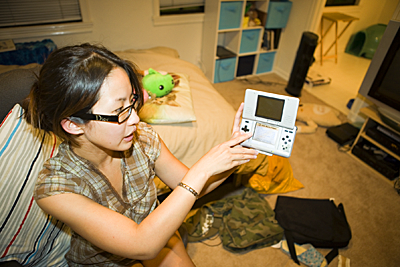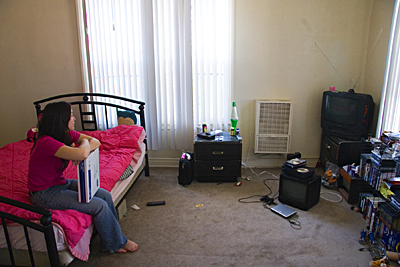Project and
Methods:
Interview:
Photography:
Valuing the richness of going to into people's homes


 Only four of the interviews were conducted in the women's homes. By doing so it is possible to capture the rich texture of their lives, as well as minor details for later analysis. When ever possible interviews should be conducted in peoples homes and their space photographed well.
Only four of the interviews were conducted in the women's homes. By doing so it is possible to capture the rich texture of their lives, as well as minor details for later analysis. When ever possible interviews should be conducted in peoples homes and their space photographed well.The Lord of the Rings, Extra Work, and Women & Money. They form a wonderful portrait of a struggling actress who just quit her straight job to focus more on acting, who loves video games, and fantasy stories. Beyond finding wonderful tableaus, photography can also be used for documenting complex things--like a bookcase--for later indexing. However, the primary reason for taking photos in the person's home is to gather the texture of their life through the place they live.
Photography, especially if it may be used publicly later, can be a far greater intrusion than the interview. It is important that the participants have made an informed consent to photography and understand what will be photographed and why, before cameras come out. It is a good practice to have a pre-written shot list, both to ensure all necessary photos are taken but also to assure the participant that their home isn't being photographed at random and without reason. In order to preserve authenticity it is not advisable for the participants to see the list in advance, just as they would not be shown the questions in advance of asking them. Just like the interview though, participants should always be given the option to opt out of any specific photo. In Women Who Play no one objected to any photos. In the Blux study, one father did object to photos being taken in one room, but that was the only objection and the other photos were taken without incident.
Unfortunately, the Women Who Play study did not include a strong photographic aspect. Taking many, random photos in a subject's home had been done for Blux. However, those photos were never used in any substantive way. They became a pool of 1,300 images used for various presentations but were not analyzed or synthesized or used in a meaningful way. For Women Who Play photos were taken but only a few and not following any specific method beyond taking "high quality photographs". This was a mistake. It was a conscious decision to take less photos. In order to conduct several interviews in a day and not to spend an overly long amount of time in each person's home, the photo session was kept short, approximately 20 minutes. However, the wrong lessons were learned from Blux. The problem was not the number of photos taken or their quality. Rather, the issues were the methodology used for taking photos and what was done with them afterwards.
After working with undergraduate students on their own photo research projects (designed by Sean Donahue) a better method became clear. First, a deliberate approach should be chosen before taking photos. This should be as specific as possible including the type of camera, angles, subjects, time of day, perspective, etc. This is for more than just consistency between subjects. By working with a specific approach the meaning of the photos change. The viewer doesn't have to wonder why any individual photo was taken, they will know the intent already. Also observations from the photos now have a base reason to rest on they are no longer random photos, but photos taken in a certain way. Second, the photos should be used. They can be closely read as individuals or a group, or the content of the photos could be used for design experimentations to form things like typologies or juxtapositions. What is important is that the content of the photos is used for further inquiry, not the form of the photos themselves (as pretty images or interesting shapes, etc.).
The undergraduates' photos are all taken in public spaces which affords them more time and boldness than working in someone's home. The best structure for taking photos in correlation with an in-home interview still need to be found.